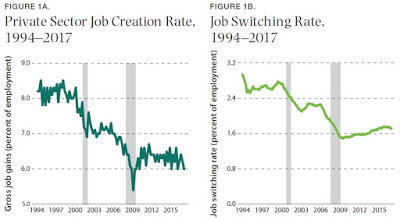Economists have recognized for a long time that in negotiations between employers and workers, the employer has a built-in advantage. John Bates Clark, probably the most eminent American economist of his timeJohn Bates Clark put it this way in his 1907 book, Essentials of Economic Theory
“In the making of the wages contract the individual laborer is at a disadvantage. He has something which he must sell and which his employer is not obliged to take, since he [that is, the employer] can reject single men with impunity. …A period of idleness may increase this disability to any extent. The vender of anything which must be sold at once is like a starving man pawning his coat—he must take whatever is offered.”
Are there some ways to tip the balance a bit more toward workers? Jay Shambaugh and Ryan Nunn have edited an ebook, Revitalizing Wage Growth: Policies to Get American Workers a Raise, with nine chapters on causes of wage stagnation and policy proposals to address it (published by the Hamilton Project at the Brookings Institution, February 2018, full Table of Contents is appended below). Given that the US unemployment rate has now been 5% or less for more than two years, since September 2016US unemployment ratethe question of wage growth is rightfully assuming high importance.
In an overview essay, “How Declining Dynamism Affects Wages,” Jay Shambaugh, Ryan Nunn, and Patrick Liu point out that labor markets have come less dynamic. A dynamic market is always experiencing gross creation of jobs and gross losses of jobs, which together make up net job creation. But gross job creation is down. So is employer-to-employer movement. So are the levels of start-up firms, which are often a source of productivity growth and new job hires.


I found several of the chapters about improving worker bargaining power to be especially interesting.
For example, Matt Marx argues for “Reforming Non-Competes to Support Workers.”














Leave A Comment